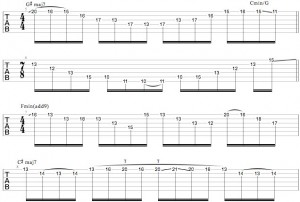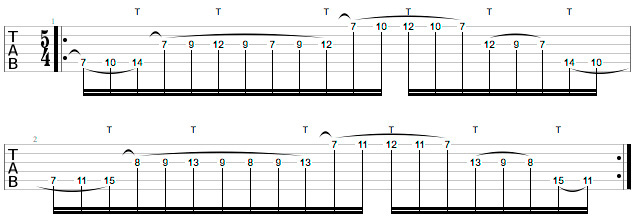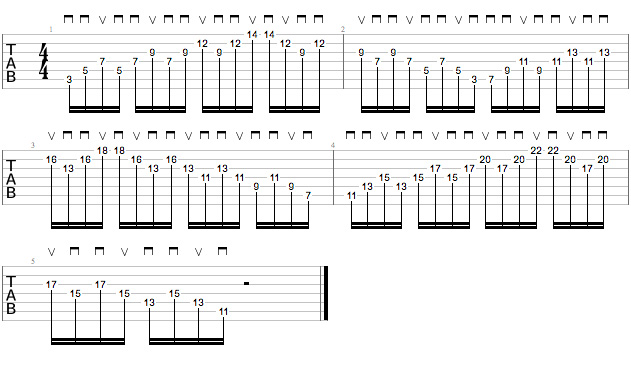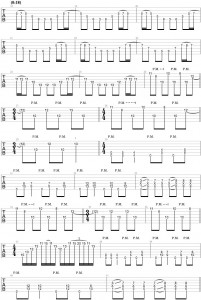This lesson will explore tapping sequences that depart from the typical rock and metal patterns we all know and love. To drive this lesson, I will be extracting two sections from ‘Warp,’ the unaccompanied solo from my debut Shrapnel release Midnight Drive. All examples involve hammer-ons from nowhere in the left hand. The first three examples use the right hand’s middle finger to tap out notes, while the last three use the first and third fingers. I like using the middle finger for the single taps because I hold the pick in between my index finger and thumb.
Using the right hand to tap out notes can create sounds that would otherwise be very difficult to achieve. Almost any tapping lick can be played without using tapping; however, chances are it will not sound exactly the same. I always encourage trying to execute a lick many different ways, but for the sake of this lesson we will stick with one approach.
Section 1 – Stacked Intervals
The first two examples are twelve-note patterns that are created primarily from stacked intervals. It is a good idea to dissect these twelve-note patterns into four chunks of three to help zero in on any potential sticking points. Also, by moving these little chunks up or down frets, new tonalities can be reached with little change in the shape.
Example 1
Example 1 is a twelve-note sequence of notes defining an F#minor7(11) arpeggio:
Creative Tapping Sequences – Example 1
Example 2
Example 2 illustrates how moving chunks around can change the tonality of the arpeggio while keeping the shape very closely intact. The notes in this example create a Dmajor7(9,11,13) arpeggio:
Creative Tapping Sequences – Example 2

Example 3
For example 3, we take these twelve-note patterns and string them together to create a larger example that also includes a Bminor7(11) arpeggio in Measure 2, which shares the same shape as the F#minor7(11) arpeggio, and an Fmajor7(9,11,13) arpeggio in Measure 5, which shares the pattern of the Dmajor7(9,11,13) arpeggio.
To end the example, we throw in a line derived from the notes of an F major scale just to change things up a bit. You may need to practice muting around the tapped bends at the end, in order to keep other strings from ringing out and muddying up the sound:
Creative Tapping Sequences – Example 3
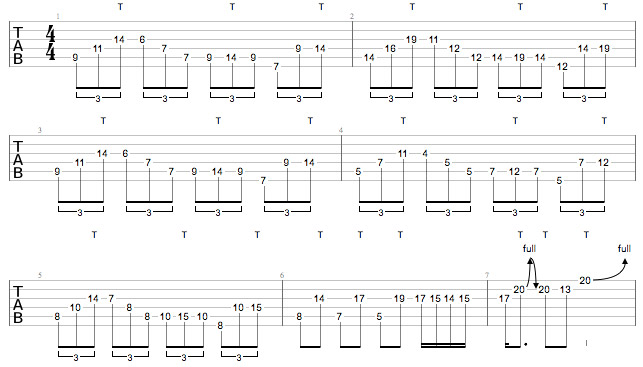
Section 2 – Adding Arpeggios
For example 4 and 5, we expand the pattern to fourteen notes and add the ring finger of the right hand into the tapping mix. I like to break these two examples into chunks of four, four, and six. The first two chunks of four are stacked 5th intervals and the chunk of six is either a major or minor arpeggio shape depending on the example.
Example 4
Example 4 is a fourteen-note sequence of notes defining an F#minor7(11) arpeggio:
Creative Tapping Sequences – Example 4

Example 5
Example 5 is a fourteen-note sequence of notes defining a Gmajor7(9,13) arpeggio:
Creative Tapping Sequences – Example 5

Example 6
For example 6, we take these fourteen-note sequences and string them together to create a larger example that also includes a C#min7(9) arpeggio in measure 2, Emin7(11) arpeggio in Measures 5 and 7 and a Bmin7(9) arpeggio in Measure 6 . To end the example we change things up a bit with a pedal idea around 5th intervals:
Creative Tapping Sequences – Example 6
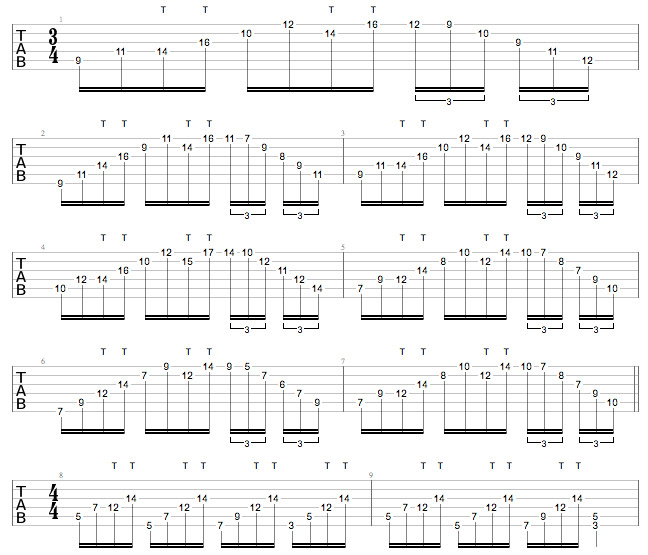
When practicing all of these examples, it helps to have low action and a string mute placed close to the nut. Use a metronome initially to work up the examples to speed, paying close attention to timing. Start slowly at first, but don’t be afraid to switch over to full speed for a bit, even if it doesn’t sound good at first. It is important for the mind and fingers to know what to expect when you’re ready to throw the lick into warp drive.




